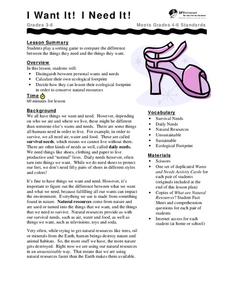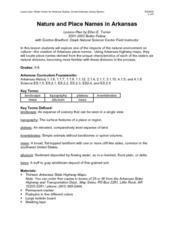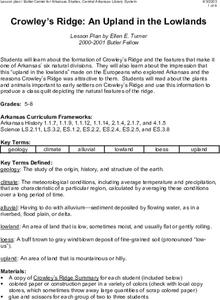City and County of San Francisco
I Want It! I Need It!
Discuss wants and needs with your elementary ecologists and get them to consider what would happen to our natural resources if we all got everything that we want. Learners play a card sorting game and take an ecological footprint quiz on...
Serendip
Evolution of Fur Color in Mice – Mutation, Environment and Natural Selection
Most species of animals include a variety of fur or hair color, but why? Scholars watch a video about a changing environment for mice. As the rocks around them change hues, different colors of mice begin to thrive. Discussion questions...
TryEngineering
Data Representation: Millions of Colors
How many colors do you know? The lesson teaches scholars how digital devices use binary and hexadecimal representations to store colors. They learn how millions of colors are available on these devices.
Curated OER
Nature and Place Names in Arkansas
Middle schoolers examine the way that many place names in Arkansas came to be. By looking at Arkansas highway maps, they find names that come from the characteristics of each of the state's six geographical divisions. This interesting...
Huntington Library
Light in Painting
How do painters use and manipulate light in their artwork to give emphasis and establish mood and emotion? Pupils will analyze a few examples of landscape and portrait painting in order to explore the how light is used in art, and will...
Curated OER
Nature Art
In this nature art lesson, students take a nature walk and collect items with different sizes, textures and colors. Students use the items they collect to make a collage.
Curated OER
Crowley's Ridge: An Upland in the Lowlands
This clever lesson combines elements of geography, art, literature, and storytelling. Pupils take a close look at the six geographical regions of Arkansas, and pay close attention to Crowley's Ridge - which is one of the six. In groups,...
Curated OER
The Colors of Seasons
Students observe each season and and mark the colors they see. In this colors of the seasons lessons, students read The Mystery of the Missing Hummingbirds and compare their results and note variations of colors in the different...
EngageNY
Analyzing Images and Language: Inferring about the Natural Disaster in Eight Days
Pictures often reveal different meanings. Scholars analyze the images in Eight Days and discuss how they add meaning to the text. Readers answers questions about how specific colors are used to create different emotions. Learners then...
Curated OER
Crowley's Ridge: An Upland in the Lowlands
Young geographers examine how Crowley's Ridge was formed. This is one Arkansa's six natural geologic divisions. The history of Crowley's Ridge is important in that the first settlers of the state were attracted to this region, and it...
Curated OER
Flower Painting/Printmaking
Using old or donated flowers, little learners create flower prints. They discuss the colors found in nature, paint a background, and then create flowers for their pictures by dipping and pressing real flowers onto their paper.
Curated OER
Natural Selection
Students comprehend that natural selectionis the tool for adaptation and evolution of populations. They pick three M&M's and no candy corns. Students tally the number of different color M&M's chosen. They discuss why colors...
Alabama Wildlife Federation
Colors to Dye for!
Nature provides a rainbow of colors at one's fingertips. A hands-on activity uses natural plant materials to create all-natural dyes. Plants range from fruits and vegetables to flowers and greens. After extracting the pigments, eager...
Curated OER
Beans and Birds: A Natural Selection Simulation
High schoolers solve the following problem concerning the evolution of seed color in pinto bean plants: "How does natural selection change the frequency of genes or traits over many generations?" They use the constructivist approach to...
Curated OER
The Chips Are Down: A Natural Selection Simulation
Students, in teams, use different colored paper chips to represent prey and a piece of fabric as the environment.
California Academy of Science
Color Vision Genetics Evolution Simulation
At one point, all mammals carried only two color receptors, but now most humans carry three. An informative presentation and hands-on activity demonstrate how this evolved through genetics. By participating in the activity, pupils...
Curated OER
Nature Walk
Students participate in a mini field trip around the neighborhood to observe nature and changes that are occurring during fall. They collect leaves of various colors, shapes and sizes on their trip. Upon return to the classroom, they...
Curated OER
A Simple Model for Natural Selection
Do you have what it takes to survive as a fit predator or will elusive prey lead to your extinction? Find out in a creative natural selection activity. Using different colors and shapes of grains to represent different species and...
California Academy of Science
Pollution in Our Watershed
The concept of a how pesticides and other chemicals pass through a watershed can be difficult for younger learners to grasp without a concrete example. In the activity here, some blank paper, markers, and a spray bottle are all you need...
Curated OER
Pocket Full of Posies: Ceramics
After studying the plant or flower life cycle, have the class create a basket of flowers out of clay. They hone their ceramics skills while they push, pull, then paint clay to look like flowers they've seen in nature. There are several...
Virginia Department of Education
Atomic Structure: Elements
It's all relevant, really. Individuals use the scientific method to learn more about elements, atoms, and their placement on the periodic table. They conduct experiments using materials common in nature to explore how elements affect our...
Curated OER
The Color of Your Own
Students understand primary and secondary colors. In this lesson about colors, students explore where colors come from. Students paint a picture with the primary paint colors that the teacher has created. Students mix the primary paint...
Curated OER
Water Cycling in the Wilderness: Alaska quarter reverse
The Alaskan wilderness contains every imaginable element of the water cycle: it has flowing streams, cool spring rain, and frozen glaciers. Pupils use a series of worksheets to identify and define evaporation, condensation, and...
Curated OER
Can You Make It? Using Natural Resources to Survive
Seventh graders describe the natural resources used to make the tools and weapons which best suited the needs of the Cherokee Indians. They will collect information regarding the making of a tool or weapon, and then explain to others...

























